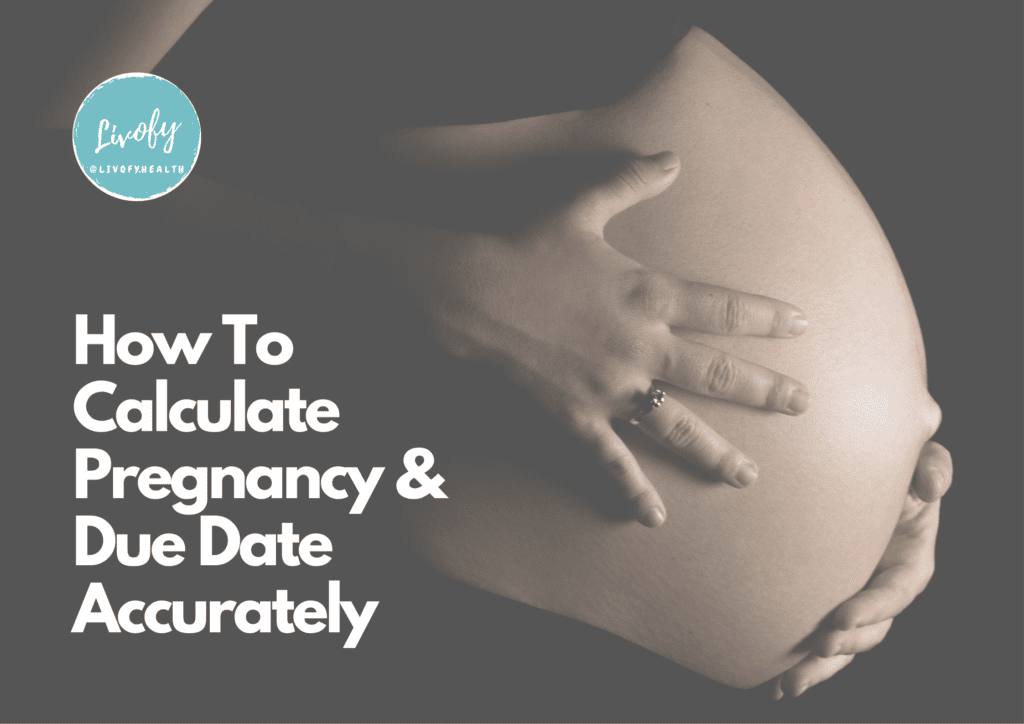Why Knowing Your Due Date Is Important?
Wondering how is due date calculated? Have a question like: how many weeks am i pregnant from my last period? Well, human fetuses fully develop in the womb for roughly 38 weeks (266 days). While calculating pregnancy, know that your due date is the day you should give birth in accordance with this 38-week gestation period.
But bear in mind that medical professionals define a full-term pregnancy as lasting between 37 and 42 weeks. Babies can arrive at any moment, and a variety of circumstances affect both the timing of your labor and the birth of your child.
Knowing your projected delivery date and how to calculate pregnancy will help you plan ahead and get ready to welcome your child. It’s vital to know your due date for preparation considerations.
You’ll have enough time to prepare for the hospital and purchase the baby’s necessities, such as a car seat. Counting down the days until the new baby is born can help siblings get ready for a new family member if you have older kids.
Knowing your due date and calculating pregnancy also enables you to receive the proper prenatal care. Prenatal care during your pregnancy should involve taking prenatal vitamins and receiving prenatal screenings at the appropriate intervals. Throughout your pregnancy, your healthcare professional will measure the fetus to make sure it is developing normally.
Due dates are merely estimates. After 37 weeks, medical professionals consider a pregnancy to be full term. So, be aware that you can give birth to your child before or after the due date.
Your doctor can inform you about how is due date calculated or that your due date has changed when you go in for an ultrasound. Fetal measures can occasionally reveal that you aren’t as far along as you believed. Alternatively, if the fetus is larger than anticipated based on your due date, your physician might move up your due date a few days. Everything about this is normal. Additionally, use a pregnancy calendar or pregnancy date calculator instead.
Other Methods to calculate your Due Date
Pregnancies typically last 280 days, or 40 weeks, beginning on the first day of the final regular period. Use either a pregnancy calendar, pregnancy date calculator or methods 1 through 3 below can be used to how to calculate pregnancy:
- Find the first day of your most recent period first.
- Then subtract 3 months from that date on the calendar.
- Lastly, raise that date by 1 year, 7 days.
For instance: Your last period started on September 9, 2010. June 9, 2010, or three calendar months in the past. Your projected due date would be June 16, 2011, after adding 1 year and 7 days.
Naegele’s Rule is a three-step process that is based on a typical 28-day menstrual cycle. As a result, dates might need to be changed to account for longer or shorter menstrual cycles.
How To Calculate Due Date: Naegele’s Rule
Naegele’s rule for how to calculate pregnancy (calculating pregnancy) entails a straightforward calculation: Your LMP’s first day is multiplied by seven, and the first three months are subtracted.
If your LMP was November 1, 2017, for instance:
tack on seven days (November 8, 2017).
Take three months out (August 8, 2017).
If required, change the year (to the year 2018, in this case).
The deadline in this case would be August 8, 2018.
How To Calculate Due Date: Period Wheel
Utilizing a pregnancy wheel for how to calculate pregnancy (calculating pregnancy) is the alternative method of determining your due date. Most doctors employ this technique. If you have access to a pregnancy wheel, estimating when you will give birth is extremely simple.
Finding the date of your LMP on the wheel is the first step. The wheel shows your due date when you align that day with the indicator.
Keep in mind that the due date is merely a rough prediction of when you will give birth. The chances of actually having your baby on that exact date are very slim.
How To Calculate Due Date: Ultrasound Scan
Sonogram or ultrasound scans are completely painless and secure. They take an image of the fetus using high-frequency sound waves to monitor the development of the fetus and the status of your pregnancy and can be a good method to learn how to calculate pregnancy (calculating pregnancy).
One way your doctor can determine how far along you are in your pregnancy is by using the ultrasound, which can pick up the fetus’s heartbeat in the sixth week.
The first ultrasound, performed between 10 and 14 weeks, is thought to be the most precise way to determine when you become pregnant.
How To Calculate Due Date: Mittendorf-Williams Rule
The Mittendorf-Williams Rule, for how to calculate pregnancy (calculating pregnancy) named after epidemiologist Michelle Williams and assistant professor Robert Mittendorf of obstetrics and gynecology at the University of Washington, uses 16 significant factors, including maternal age, pre-pregnancy weight, race, college education, use of alcohol and coffee, hypertension, and other medical conditions, to more accurately date the pregnancy and determine whether a woman is at risk for preterm birth.
Two studies serve as the foundation for the Mittendorf-Williams rule:
- According to 1990 research, for Caucasian first-time mothers, pregnancy lasted an average of 288 days following a woman’s last menstrual period (LMP). The average date of delivery for Caucasian women who were not first-time mothers was 283 days following LMP (three days later than Naegele’s rule anticipated).
- According to a second study conducted in 1993, there are a variety of variables that can affect how long a pregnancy lasts, including age, race, and the number of prior births.
How To Calculate Due Date: Parikh’s Rule
Medical professionals also rarely employ Parikh’s rule, another idea for how is due date calculated that lacks empirical support, for how to calculate pregnancy. However, the theory contends that it can support due date prediction in those with irregular cycles. So how does it function?
The estimated date of delivery in Parikh’s rule is derived by adding nine months to the date of your last menstrual period, deducting 21 days, and then adding the length of previous cycles. This method is loosely based on Naegele’s rule. Use this formula, in brief:
LMP plus 280 days minus 21 days plus the typical duration of prior cycles
How To Calculate Due Date: Wood’s Rule
Wood’s technique analyses the individual duration of the menstrual cycle, as well as the number of pregnancies a person has experienced. There is, however, little research on this and its efficacy when it comes to how is due date calculated. To work it out using either a pregnancy calendar, or pregnancy date calculator or do the following:
You should first determine your anticipated due date. Use the following formulas to accomplish this and learn how to calculate pregnancy(pregnancy test calculator).
– LMP + 12 months – 2 months and 14 days = EDD for first pregnancies.
– LMP + 12 months – (2 months and 18 days) Equals EDD for subsequent pregnancies.
The following formulae then take into account the anticipated due date (pregnancy test calculator).
EDD + (actual length of cycle – 28 days) = EDD for cycles longer than 28 days.
– For cycles that are shorter than 28 days, use the formula EDD – (28 days – the actual length of the cycle) = EDD.
How To Calculate Due Date: Conception Date
You might be able to guess when conception took place if your cycle is perfectly regular and you were having sex to become pregnant at a precise time. However, it is frequently inaccurate, the conception date isn’t used medically to know how is due date calculated. Try using a pregnancy calendar or pregnancy date calculator instead.
That makes sense given that ovulation doesn’t always occur on the same day each month, sperm can survive in the female body for up to five days, and an egg can continue to be fertilized for up to 24 hours after it has been released from the ovary. This means that several days after engaging in unprotected sex, you can still become pregnant.
Factors Affecting Due Date
Why is your baby choosing to delay birth a little bit? Typical explanations include:
- It’s your first child.
- You’ve previously delivered children who were not at term.
- Post-term births are a familial tradition in your family.
- You are overweight.
- It’s a male, your child.
- Your due date was calculated erroneously.
Try using a pregnancy calendar or a Pregnancy Calculator (pregnancy test calculator) week by week to be more sure.
Important Factors To Consider During Pregnancy
Reproductive Abnormalities
Women Under Age 20
Pregnancy-related major medical issues are substantially more likely to occur in women under the age of 20 than in pregnant women over the age of 20. Teenage mothers have a higher likelihood of:
- Delivering too soon
- Experience pregnancy-induced hypertension
- Have a low birth weight baby
- Get preeclampsia
Women over age 35
Your chances of getting pregnant start to decrease as you become older. Additionally, the likelihood of a problem-free pregnancy is lower for older women who become pregnant.
among the common problems are the following:
Underlying Issues
Pregnancy can be complicated by illnesses like high blood pressure, diabetes, or cardiovascular disease, which are more prevalent in older women. These illnesses can cause miscarriage, stunted fetal growth, and birth abnormalities if they aren’t properly managed.
Chromosome Issues
Due to chromosomal problems, a woman beyond the age of 35 is more likely to give birth to a kid who has birth abnormalities.
The most frequent chromosome-related birth abnormality is Down syndrome. It results in physical deformities and intellectual incapacity of varying degrees. The likelihood of chromosomal problems can be determined through prenatal screening and testing.
Miscarriage
Women over the age of 35 have a higher risk of miscarriage, according to the Mayo Clinic. Although the cause of this is unknown, it is thought to be related to an increased risk of preexisting medical issues as well as a decline in a woman’s egg quality with age.
Even paternal age has been linked to miscarriage, according to a study by Trusted Source. If both the father and the mother are above 35, the risk of miscarriage is substantially higher than if only the woman is.
Other difficulties
Regardless of age, women over 35 are more likely to experience typical pregnancy problems, such as:
- A higher chance of having multiple pregnancies due to an increased risk of developing high blood pressure.
- Gestational diabetes while expecting (twins or triplets).
- A greater chance that low birth weight babies will require a C-section.
Weight
Obstacles can arise during pregnancy if a woman is overweight or underweight.
Obesity
Obese women are more likely than normal-weight women to experience various birth abnormalities in their offspring, such as:
- Spinning Bifida
- Heart issues
- Hydrocephaly cleft palate and lip
Obese women are also more prone to have high blood pressure or be diagnosed with gestational diabetes during pregnancy. This can result in a smaller-than-expected baby and raise the possibility of preeclampsia. Consider a Diet for Post Pregnancy Fat Loss to combat this.
Underweight
Babies born to underweight mothers who weigh less than 100 pounds are more likely to be born prematurely.
Diabetes
Both type 1 and type 2 diabetics are at risk for pregnancy-related problems. Diabetes that is not properly controlled might put the mother’s health at risk and increase the likelihood that the baby will have birth abnormalities.
If you didn’t have diabetes before becoming pregnant, you could develop it while experiencing pregnancy-related symptoms. Having gestational diabetes is what this is.
You should discuss the precise blood sugar control instructions with your doctor if you are diagnosed with gestational diabetes. Changes in diet will be advised. Additionally, keeping an eye on your blood sugar levels is encouraged.
To keep your blood sugar levels under control, you might need to take insulin. Women who have gestational diabetes have a significantly increased chance of getting diabetes after delivery.
Sexually Transmitted Infections (STIs)
STI testing ought to be done during your initial prenatal appointment. Women who have STIs are most prone to pass them on to their unborn children. A kid born to a mother who has an STI may be more susceptible to:
- A little birth weight
- Conjunctivitis
- Pneumonia
- Neonatal sepsis (bloodstream infection in the infant)
- Neurological harm
- Blindness
- Deafness
- Chronic hepatitis
- Chronic liver disease and meningitis
- Cirrhosis
The following STIs are frequently checked for during prenatal visits:
- Gonorrhea
- Chlamydia’s
- Syphilis’s
- Hepatitis B
- Hepatitis C
- HIV
These illnesses not only pose a threat to the unborn child’s health, but they can also seriously complicate pregnancies. For instance, the gonorrhoeic infection left untreated raises the possibility of miscarriage, early birth, and low birth weight.
HIV-positive pregnant women have a higher risk of passing the infection on to their unborn child or any children they breastfeed. Mothers with HIV should take HIV drugs to stop this from happening.
Such medication may be given to newborns of HIV-positive moms for a few weeks after birth. Pre-exposure prophylaxis (PrEP) can help HIV-negative women who have a partner who is HIV-positive lower their risk of contracting the virus.
Health Issues That Are Already Present
You may be more vulnerable to difficulties during pregnancy if you have certain pre-existing medical disorders. Several instances include:
Elevated blood pressure
Preeclampsia during pregnancy, preterm delivery, renal injury, and low birth weight babies are all elevated risks for pregnant women with chronic high blood pressure.
PCOS
A hormonal condition known as polycystic ovary syndrome (PCOS) can result in irregular menstrual cycles and improper ovarian function. Gestational diabetes, preeclampsia, miscarriage, and early birth are all more common among pregnant women with PCOS. Research for ways to cure PCOS, and combat this easily. Know what kind of food to eat in PCOS and foods to avoid in PCOS to be more precise.
Immune Disorder
Autoimmune illnesses include ailments like lupus and multiple sclerosis (MS), for instance. Premature labor or stillbirth may be a danger for women with autoimmune diseases.
Kidney Illness
Miscarriage is more likely in women with renal illness. Along with monitoring their food and medications, they should collaborate with their doctor the entire time they are pregnant.
Thyroid Condition
Uncontrolled hyperthyroidism (overactive thyroid) or hypothyroidism (underactive thyroid) can cause birth abnormalities as well as foetal heart failure or inadequate weight gain.
Asthma
Uncontrolled asthma increases the risk of early delivery and low fetal weight gain.
Uterine fibroids
While uterine fibroids can be rather prevalent, they rarely result in miscarriage or early delivery. When a fibroid is obstructing the birth canal, a cesarean delivery may be necessary.
How Likely Am I To Give Birth On My Due Date?
Pregnant women frequently deliver later than expected. In actuality, about 5% of pregnant women really give birth on the scheduled day. Most babies are born between 37 and 41 weeks of pregnancy, usually a week or two before or after their scheduled due date.
Approximately 12% of firstborns are born preterm, compared to 10% of other infants, according to to live births reported in the National Survey of Family Growth. Additionally, first kids are more likely to be late than other babies (approximately 15% versus 10%, assuming “late” implies after 40 weeks). Use a pregnancy calculator week by week to know for sure.
FAQs
Can my due date change?
If dating is only based on the last menstrual period and a later ultrasound shows a discrepancy, then the due date may be changed. If your due date is confirmed by ultrasound in the first trimester, it shouldn’t change as the pregnancy progresses, even with additional ultrasounds. Use a pregnancy calculator week by week to be more sure.
What if I don’t know the date of my last menstrual period?
Speak with your provider if you are unsure of the time of your last menstruation or when you became pregnant. For the purpose of determining how far along you are in your pregnancy, they will perform an examination that probably includes a prenatal ultrasound.
What if I have irregular periods or long cycles?
If you’ve always had slightly irregular periods or are still in adolescence, you don’t need to see a doctor. However, if you’re under 45 and your periods start to become irregular suddenly, visit a doctor. More frequently than every 21 days or fewer frequently than every 35 days, you experience periods.
Can I plan my due date?
In general, the most accurate way to determine your due date is to calculate 40 weeks, or 280 days, from the first day of your last menstrual period because most pregnancies last around 40 weeks (or 38 weeks from conception) (LMP). You can use a pregnancy calculator week by week as well.









